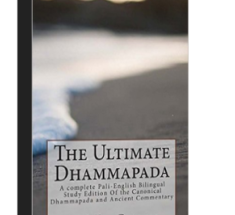 One evening about two weeks ago I picked up the Samyutta Nikaya and stumbled over a short sutta which mesmerized me for the next two weeks. It is one of those short yet deep suttas which makes the Samyutta Nikaya so special. In this particular sutta the Buddha explains his entire teaching in five simple sentences. All those mountains of ink, hours of Dhamma talks, decades of spiritual search – reduced to five short sentences. A Buddha’s awakened humor 😉 towards our desire to proliferate into eternity.
One evening about two weeks ago I picked up the Samyutta Nikaya and stumbled over a short sutta which mesmerized me for the next two weeks. It is one of those short yet deep suttas which makes the Samyutta Nikaya so special. In this particular sutta the Buddha explains his entire teaching in five simple sentences. All those mountains of ink, hours of Dhamma talks, decades of spiritual search – reduced to five short sentences. A Buddha’s awakened humor 😉 towards our desire to proliferate into eternity.
It felt like a veritable Theravadin ZEN experience, staring at those couple of lines, knowing that all the wisdom you can develop through the Buddha’s teaching is contained in a few lines, a handful of words. In other words, it is (like many other suttas) a profound call for action and like many similar discourses of the Buddha it provides an instruction, a description of the process and a definition of progress and goal – exactly what someone who wants to replicate an experiment is looking for.
What is this sutta? What are those five sentences? Have a look:
“Aniccaññeva, bhikkhave, bhikkhu rūpaṃ aniccanti passati. Sāssa hoti sammādiṭṭhi. Sammā passaṃ nibbindati. Nandikkhayā rāgakkhayo, rāgakkhayā nandikkhayo. Nandirāgakkhayā cittaṃ vimuttaṃ suvimuttanti vuccati. Aniccaññeva, bhikkhave, bhikkhu vedanaṃ…saññaṃ…saṅkhārā…viññāṇaṃ aniccanti passati. Sāssa hoti sammādiṭṭhi. Sammā passaṃ nibbindati. Nandikkhayā rāgakkhayo, rāgakkhayā nandikkhayo. Nandirāgakkhayā cittaṃ vimuttaṃ suvimuttanti vuccati.” [Nandikkhayasuttaṃ, Samyutta Nikaya, Khandhasamyutta. PTS 3.51 for the five khandhas, PTS 4.141 parallel version with for the senses. Translation further below – want you to go through this slowly, step by step, to better see the beauty ;-). Todo: Learn this by heart.]
Let’s simplify this and break it down:
Step 1 – This is what you have to do
Aniccaṃ rūpaṃ bhikkhu “aniccan” ti passati. The monks sees the impermanent form thus “impermanent”.
Aniccaṃ rūpaṃ … Impermanent form
bhikkhu … (the/a) monk
“aniccan” ti passati … he sees (passati) “impermanent” thus (aniccam iti) = He sees thus “impermanent”.
Some necessary remarks regarding the “iti passati” in the sutta.
 In a couple of older posts (here and here) we had been looking into this particular Sanskrit/Pali way of marking direct speech/thought and its application towards meditation. Pali like Sanskrit does not have what we call indirect speech. Everything you hear or think has to be expressed in a direct form in Pali, marked off with the word “iti” meaning “thus”. Interestingly enough, there is a very good way for a modern native speaker of English to understand this particular grammatical construct:
In a couple of older posts (here and here) we had been looking into this particular Sanskrit/Pali way of marking direct speech/thought and its application towards meditation. Pali like Sanskrit does not have what we call indirect speech. Everything you hear or think has to be expressed in a direct form in Pali, marked off with the word “iti” meaning “thus”. Interestingly enough, there is a very good way for a modern native speaker of English to understand this particular grammatical construct:
Translating the above into somewhat colloquial modern English we could say:
The impermanent form the monk sees like “impermanent”.
Here the Pali uses “thus” (iti) in a similar manner as the English”be like – quotative”. If you don’t know what that is please have a look at the following example:
B. Expressing the contents of one’s thought:
(Skt-2) manyate pāpakam kṛtvā “na kaścid vetti mām” iti
“After committing some sins, one thinks ‘nobody knows me’.” [Mahabharata 1.74.29; cited from Speijer[1]:§493b](Eng-2) “And I thought like ‘wow, this is for me’.” [OED, 2nd Supplement[2]; 1970, no earlier citations]
There are some great resources on this topic. If you are interested, have a look at the following links, with a lot more examples. But chances are you hear someone say “…and I like, wow, you did awesome” when you listen to (young) people talk.
- Great post on this topic: http://staefcraeft.blogspot.com/2010/09/english-like-can-like-function-like.html – see the note section below.
- Short intro: http://www.learnsanskrit.org/start/uninflected/itiva
- In depth discussion: “The syntax and semantics of be like quotatives” link http://homepage.univie.ac.at/glow34.linguistics/haddican.pdf – very interesting paper by Bill Haddican, Eytan Zweig and Daniel Johnson and their ppt presentation:
- http://qcpages.qc.cuny.edu/~whaddican/wccflq.pdf
So what does that mean with regard to meditation practice? How do we “see something as impermanent”. Is it meditation with labels as practiced in Mahasi Vipassana meditation traditions? Some form of noting process? Or meant to be “thoughtless” after all?
First of all, I really think that this instruction is complete. There is no secret meditation instruction hidden. The native Pali (Prakrit) listener knew what he had to do after listening to the above instruction (see the verse of Malunkyaputta further below).
We should probably take this sentence itself as the meditation instruction. Clearly the Buddha refers to a process of ñāṇadassanā or seeing-and-knowing time and again as the means of awakening – and this line is a perfect example of “knowing and seeing”. The Buddha refers to something that is not just “ordinary” seeing (otherwise: bhikkhu aniccam rupam passati). It is also not an exercise in thinking (otherwise: “bhikkhu rupassa aniccatam cinteti”).
Rather it has to do with kind of an observation (here in form of the verb passati; elsewhere as samanupassati or paccavekkhati). An observation which needs to be close to real time of sense-contact (otherwise there is no way to see the impermanence of forms, feeling etc.).
This clearly is an indicator of a meditative environment in which this “experiment” needs to be conducted. At the same time there seems to be an element of “knowing” which has to go along with that observation. Similar to an “addiction” we cannot expect any results “all of a sudden” (in most cases) – it will take some time. That “knowing” part of the meditative exercise has to recognize the fundamental characteristic of form, feeling…cognition. Impermanence. Whether “tagging” that experience mentally as such with a short label or not is the way to go can easily be tested if we look at step no.3 below, which defines a very precise milestone to judge our progress.
Two further quotes on this topic:
‘‘Sukhaṃ vā yadi vā dukkhaṃ, adukkhamasukhaṃ saha;
Ajjhattañca bahiddhā ca, yaṃ kiñci atthi veditaṃ. ‘‘Etaṃ dukkhanti ñatvāna, mosadhammaṃ palokinaṃ [palokitaṃ (sī.)]
Phussa phussa vayaṃ passaṃ, evaṃ tattha vijānati [virajjati (ka. sī.)]
Vedanānaṃ khayā bhikkhu, nicchāto parinibbuto’’ti.
From the amazing Dvayatanupassana Sutta in the Sutta Nipata, v.743-44:
“Pleasant or painful, neither pleasant nor painful also,
Inside or from outside – whatever there is to be felt:
Having perceived it “this is painful” thus,
A treacherous thing, bound to breaking up again,
Hit and hit (over and over by sense-contact) while seeing the passing away –
There, in such a way, he knows [or: he becomes dispassionate – altern. reading].
Through the destruction of feelings the monk becomes desireless, fully extinguished.
and similarly:
‘‘Na so rajjati rūpesu, rūpaṃ disvā paṭissato;
Virattacitto vedeti, tañca nājjhosa tiṭṭhati.
‘‘Yathāssa passato rūpaṃ, sevato cāpi vedanaṃ;
Khīyati nopacīyati, evaṃ so caratī sato;
Evaṃ apacinato dukkhaṃ, santike nibbānamuccati.
He does not delight in forms, having seen a form he remembers (lit. back-remembers, i.e. comes back to his meditation object)
With a dispassionate mind he feels it, and does not grasp (does not rest) on this form. When he sees form like that, and experiences feeling in such a way,
It falls away, it does not amass, thus he practices remembering/witnessing.
Thus suffering/pain is reduced, and close is he to the extinction (Nibbana), they say.
[For more info on this passage see this post: Malunkyaputta’s vipassana instruction]
Step 2 – Look, 8-fold path, 4 noble truth – all included!
Sā assa hoti sammādiṭṭhi. This is his right view.
Sā … (fem. sg. pron.) This (fem.), She [right view]
assa … to him, his
hoti … is
sammādiṭṭhi … right view.
 Fascinating. So the above way of looking at form (and feeling, perception, mental activities and cognition) – seeing those five elements (or what constitutes the entirety of our “being” in each conscious moment) as impermanent is – according to the Buddha in this sutta – the practice of right view. Right view is not an opinion. It is a way of observing ourselves in a real-time psychological manner without giving thoughts and mental constructs any habitat. As the brahmins at the time of the Buddha used to say, after learning about the Buddha’s teaching – “wow, all we ever studied was hear-say (itihasa) – your teaching is timeless, immediate”.
Fascinating. So the above way of looking at form (and feeling, perception, mental activities and cognition) – seeing those five elements (or what constitutes the entirety of our “being” in each conscious moment) as impermanent is – according to the Buddha in this sutta – the practice of right view. Right view is not an opinion. It is a way of observing ourselves in a real-time psychological manner without giving thoughts and mental constructs any habitat. As the brahmins at the time of the Buddha used to say, after learning about the Buddha’s teaching – “wow, all we ever studied was hear-say (itihasa) – your teaching is timeless, immediate”.
Again, right view is explained in many Sutta’s as the realization of the four noble truths. Here the Buddha summarizes in one line, that the real realization of the four noble truths is born out of the simple observation of nature. Knowing suffering/pain, its origin, its cessation and even the path(!) will be understood and realized by the student who applies himself to step 1. If stream entry is your true goal, put your books away 😉
Step 3 – This is what will happen to you – and if it doesn’t something is wrong.
Sammā passaṃ nibbindati. Seeing correctly he becomes disenchanted.
Sammā … Right, correct.
passaṃ … seeing (pres. part.)
nibbindati … he gets fed up with, wearied of, satiated, disgusted with, disenchanted, disillusioned. Literally from nir+vindati – to find (vindati) nothing [see http://glossary.buddhistdoor.com/en/word/98321/nibbindati].
So here we get a wonderful guideline for our meditation. According to the Buddha our mode of observation has to lead to nibbida – some kind of “disgust, dissatisfaction, disenchantment” with the five aggregates. If it does that, we are on the right path. If we see more delusion or infatuation then something about our approach must be wrong.
Step 4 – Watch out for a transformation to occur
Nandikkhayā rāgakkhayo, rāgakkhayā nandikkhayo. With the waning of delight wanes passion. With the waning of passion wanes delight.
nandi… delight, fun.
rāga… passion, color, desire.
khayo … destruction, waning, decay.
This formula is quite particular. The first thing I am reminded of is the simile of “love lost” where the Buddha equates the term nandi-raga with the passion/emotion we feel towards someone we believe belongs to us, but who betrays us and thus creates pain. He doesnt even say “this is similar” – no, he uses the exact same expression. See that post here, for cross-reference and more details here.
Look at this nice list for how the word ksaya (sanskr.) was associated: http://vedabase.net/k/ksaya
Step 5 – And finally, you are done. Awakened like the Buddha.
Nandirāgakkhayā cittaṃ vimuttaṃ, “suvimuttan” ti vuccati. With the destruction of delight and passion the mind is de-tached. “Fully de-tached” thus it is said.
Nandirāgakkhayā … from the delight-passion-destruction (abl).
cittaṃ … the mind.
vimuttaṃ… vimutta (ppp. from muñcati – to loosen, release) = detached, or even closer “vi- (ab-) mutta (geloest)” in German.
“suvimuttam” iti vuccati …. “well-freed” thus it is called.
 A perfect description of “enlightenment” or “awakening” by the Buddha. Clear, straight forward, almost clinical in its description of what the Arahants mind “feels” like from the inside. If you share this truly, congratulations, kata-kiccham – your job is done.
A perfect description of “enlightenment” or “awakening” by the Buddha. Clear, straight forward, almost clinical in its description of what the Arahants mind “feels” like from the inside. If you share this truly, congratulations, kata-kiccham – your job is done.
What else needs to be said? 😉
Or in the words of the Buddha:
Whatever should be done, monks, by a compassionate teacher out of compassion for his disciples, desiring their welfare, that I have done for you. These are the feet of trees, monks, these are empty huts. Meditate, monks, do not be negligent, lest you regret it later. This is our instruction to you.” (The Connected Discourses of the Buddha, p. 1378)
And celestial coral flowers and heavenly sandalwood powder from the sky rain down upon the body of the Tathagata, and drop and scatter and are strewn upon it in worship of the Tathagata. And the sound of heavenly voices and heavenly instruments makes music in the air out of reverence for the Tathagata. 6. “Yet it is not thus, Ananda, that the Tathagata is respected, venerated, esteemed, worshipped, and honored in the highest degree. But, Ananda, whatever bhikkhu or bhikkhuni, layman or laywoman, abides by the Dhamma, lives uprightly in the Dhamma, walks in the way of the Dhamma, it is by such a one that the Tathagata is respected, venerated, esteemed, worshipped, and honored in the highest degree. Therefore, Ananda, thus should you train yourselves: ‘We shall abide by the Dhamma, live uprightly in the Dhamma, walk in the way of the Dhamma.'”
…
And the Blessed One addressed the bhikkhus, saying: “Behold now, bhikkhus, I exhort you: All compounded things are subject to vanish. Strive with diligence!” (Digha Nikaya, Mahaparinibbana Sutta)
Notes:
========================================
Comparing ITI with english LIKE
Quoting from
http://staefcraeft.blogspot.com/2010/09/english-like-can-like-function-like.html
“Both Sanskrit iti and English like can occur in the following contexts:
A. When quoting words actually utttered, alongside a verb of speaking:
(Skt-1) kathitam avalokitayā “madanodyānam gato mādhava” iti
“Avalokita had told me that Madhava was gone to the grove of Kama.” [Mālatīmādhava I, p. 11; cited from Speijer[1]:§493a]
(Eng-1) “She said like ‘I want to go too’.”
B. Expressing the contents of one’s thought:
(Skt-2) manyate pāpakam kṛtvā “na kaścid vetti mām” iti
“After committing some sins, one thinks ‘nobody knows me’.” [Mahabharata 1.74.29; cited from Speijer[1]:§493b]
(Eng-2) “And I thought like ‘wow, this is for me’.” [OED, 2nd Supplement[2]; 1970, no earlier citations]
C. More general setting forth of motives, emotions, judgements etc.:
(Skt-3) vyāghro mānuṣam khādati iti lokāpavādaḥ
“‘The tiger eats the man’ is slanderous gossip.” [Hitopadesha10; cited from Speijer[1]:§493c]
(Eng-3) “I was like ‘wow’!”
There are obvious differences between English quotative like and Sanskrit iti, including the fact that English quotative like precedes the “quotation”, while Sanskrit iti follows it (in conformity with the general left-branching nature of Sanskrit syntax).
Further, Sanskrit iti doesn’t have any of the other functions or meanings associated with English like. English like derives ultimately from Proto-Germanic *lîko– “body, form, appearance”, while Sanskrit iti is built from the pronominal stem i-. In fact, itistill has pronominal uses, even in Classical Sanskrit, as in the following example.
(Skt-4) tebhyas pratijnāya nalaḥ kariṣya iti
“Nala promised them he would do thus.” [Nala 3,1; cited from Speijer[1]:§492]
Amusingly, I find that (pretending that a parallel development has taken place in English) replacing “quotative” like with thus actually seems grammatical to me—though wholly unidiomatic, e.g.:
(Eng-4) “I was thus: ‘Wow!'”
(Somehow I imagine that if thus had been recruited as a quotative in English rather than like, the use of a quotative marker wouldn’t be so stigmatised, since there would be no association with fillerlike and, moreover, thus is largely used in formal registers of English.)
However, there is another element in Sanskrit which—though not as frequently used in this function as iti—actually is more similar to English quotative like in its syntax and semantics: yathā. Yathāis, properly speaking, a relative pronoun and is often part of relative-correlative constructions of the form yathā X…tathā Y“As X…., so Y”. However, it can occur without correlative tathā, and in fact can have the meaning “like”, as in the following example:
(Skt-5) mansyante mām yathā nṛpam
“They will consider me like a king.” [Mahabharata 4.2.5; cited from Speijer[1]:§470a]
Yathā can also function as a sort of quotative, but—unlike iti and like like—it precedes rather than follows the quoted discourse:
(Skt-6) viditam eva yathā “vayam malayaketau kimcitkālāntaram uṣitāḥ”.
“It is certainly known (to you) that I stayed for some time with Malayaketu.” [Mudrarakshasa VII; cited from Speijer[1]:§494]
(Or, maybe: “You certainly know, like, ‘I stayed for some time with Malayaketu’.”)
(Yathā and iti (since they occupy different syntactic positions) can also co-occur.)
So there is at least one antique parallel for the development of modern English like as a quotative marker.
Returning to the more commonly used iti, the following Sanskrit example—occurring when one of the heroes of the Mahabharata has performed an act of generosity so great that even the gods are impressed—I think is a great parallel for examples like “I was like, ‘Wow!'”:
(Skt-7) tato ‘ntarikṣe vāg āsīt “sādhu sādhv” iti
“Then a voice in the sky was like ‘Wow! Wow!'” [Mahabharata 14.91.15]
This line might be more usually translated as “then a voice in the sky said ‘Bravo! Bravo!'”, but there is actually no verb of speaking:āsīt means “was”.
===================
Nibbindati [nis+vindati, vid2] to get wearied of (c. loc.); to have enough of, be satiated, turn away from, to be disgusted with. In two roots A. vind: prs. nibbindati etc. usually in combn with virajjati & vimuccati (cp. nibbāna III. 2). Vin i.35; S ii.94; iv.86, 140; A v.3; Dh 277 sq.; It 33; J i.267; Miln 235, 244; Sdhp 612. ppr. nibbindaŋ S iv.86; PvA 36 (nibbinda — mānasa); ger. nibbindiya J v.121 (˚kārin). — B. vid: Pot. nibbide (v. l. BB nibbije) J v.368 (=nibbindeyya Com.); ger. nibbijjitvā J i.82, & nibbijja Sn 448=S i.124 (nibbijjâpema=nibbijja pakkameyya SnA 393). — pp. nibbiṇṇa. See also nibbidā.
==============
Khaya [Sk. kṣaya to kṣi, kṣiṇoti & kṣiṇāti; cp. Lat. situs withering, Gr. fqi/sis, fqi/nw, fqi/w wasting. See also khepeti under khipati] waste, destruction, consumption; decay, ruin, loss; of the passing away of night VvA 52; mostly in applied meaning with ref. to the extinction of passions & such elements as condition, life, & rebirth, e. g. āsavānaŋ kh. It 103 sq., esp. in formula āsavānaŋ khayā anāsavaŋ cetovimuttiŋ upasampajja A i.107= 221=D iii.78, 108, 132=It 100 and passim. — rāgassa, dosassa, mohassa kh. M i.5; A i.299, cp. rāga˚, dosa˚, moha˚, A i.159; dosa˚ S iii.160, 191; iv.250. — taṇhānaŋ kh. Dh 154; sankhārānaŋ kh. Dh. 383; sabbamaññitānaŋ, etc. M i.486; āyu˚, puñña˚ Vism 502. — yo dukkhassa pajānāti idh’ eva khayaŋ attano Sn 626=Dh 402; khayaŋ virāgaŋ amataŋ paṇītaŋ Sn 225. — In exegesis of rūpassa aniccatā: rūpassa khayo vayo bhedo Dhs 645=738=872. — See also khīṇa and the foll. cpds. s. v.: āyu˚, upadhi˚, upādāna˚, jāti˚, jīvita˚, taṇha˚, dukkha˚, puñña˚, bhava˚, loka˚, saŋyojana, sabbadhamma˚, samudda˚.
— âtīta (a) gone beyond, recovered from the waning period (of chanda, the moon=the new moon) Sn 598; — ânupassin (a) realizing the fact of decay A iv.146 sq.= v.359 (+vayânupassin); — ñāṇa knowledge of the fact of decay Mii.38=Pug 60; in the same sense khaye ñāṇa Nett 15, 54, 59, 127, 191, cp. kvu 230 sq.; — dhamma the law of decay A iii.54; Ps i.53, 76, 78.
===============
Nandi1 & (freq.) Nandī (f.) [Sk. nandi, but cp. BSk. nandī Divy 37] 1. joy, enjoyment, pleasure, delight in (c. loc.) S i.16, 39, 54; ii.101 sq. (āhāre); iii.14 (=upādāna); iv.36 sq.; A ii.10 (kāma˚, bhava˚, diṭṭhi˚), iii.246; iv.423 sq. (dhamma˚); Sn 1055 (+nivesana); Nd2 330 (=taṇhā); Pug 57; Dhs 1059≈(in def. of taṇhā); Vbh 145, 356, 361; DhsA 363; ThA 65, 167. — For nandī at Miln 289 read tandī. — 2. a musical instrument: joy — drum [Sk. nandī] Vin iii.108 (=vijayabheri). Cp. ā˚.
— (y)āvatta “turning auspiciously” (i. e. turning to the right: see dakkhiṇāvatta), auspicious, good Nett 2, 4, 7, 113 (always attr. of naya); — ûpasecana (rāgasalla) sprinkled over with joy, having joy as its sauce Nett 116, 117; cp. maŋsûpasecana (odana) J iii.144=vi.24; — kkhaya the destruction of (finding) delight S iii.51; — (ŋ)jaha giving up or abandoning joy Sn 1101 (+okañjaha & kappañjaha); Nd2 331; — bhava existence of joy, being full of joy, in˚parikkhīṇa one in whom joy is extinct (i. e. an Arahant), expld however by Com. as one who has rid himself of the craving for rebirth (tīsu bhavesu parikkhīnataṇha DhA iv.192=SnA 469) S i.2, 53; Sn 175, 637=Dh 413; — mukhī (adj. — f.) “joyfaced,” showing a merry face, Ep. of the night (esp. the eve of the uposatha) Vin i.288 (ratti); ii.236 (id.); — rāga pleasure & lust, passionate delight S ii.227; iii.51; iv.142, 174, 180; M i.145; Dhs 1059≈, 1136; esp. as attr. of taṇhā in phrase n — r — sahagata — taṇhā (cp. M Vastu iii.332: nandīrāgasahagatā tr̥ṣṇā) Vin i.10; S iii.158; v.425 sq.; Ps ii.137; Nett 72; — saŋyojana the fetter of finding delight in anything Sn 1109, 1115; Nd2 332; — samudaya the rise or origin of delight M iii.267.




3 comments